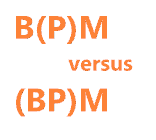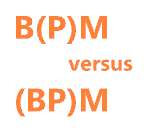Is this where you want to be?
Blog: KWKeirstead's Blog
This is a pitch to consultants and business managers who subscribe to and use BPM (Business Process Management). 
It turns out there are two flavors of BPM and these are “B (P)M” (business management with orchestration from process templates) and “(BP)M” (management by processes). Any similarity between the two ends here.
If you put a focus on B(P)M what this means is that you are subscribing to the use of BPM to provide background workflow orchestration at Cases – this impacts efficiency and effectiveness.
(BP)M, on the other hand, puts too sharp a focus on processes – you impact efficiency, but only only minimally impact effectiveness, unless your processes are all end-to-end processes.
If you are up to it, and your clients are on board, clearly, B(P)M is where you will want to be.
Transitioning from (BP)M to B(P)M requires a change in mindset, so here are a few tips & tricks.
Most (BP)M consultants come from a background of end-to-end processes. Mapped end-to-end processes are easy to roll out to production environments. You have one start task and one end task (e.g. “cutting the ribbon”). The objective is to get to the end task. Your process map details what, why, who and, to an extent, where and when.
B(P)M is different.
Most of the process management clients are looking for today are not end-to-end processes.
What we have instead are “process fragments” that get threaded together at run time by workers, software and machines. Process fragments do not have any plan-side objectives.
Under B(P)M, objectives become a property of run-time Case i.e. a patient, an insurance claim, a helicopter under MRO. For our discussion purposes here, Case is not equivalent to “use-Case”.
Process fragments continue the tradition of what, why, who, where and when, except that some of the interventions are now ad hoc interventions. Tasks at Cases become a mix of structured and unstructured interventions and this adds variability to where and when.
“Ribbon-cutting” at a Case under B(P)M takes place when the Case Manager closes the Case – no exceptions!
As and when you transition to B(P)M, your legacy BPMS will need major surgery.
As explained, your new BPMS will need to accommodate any mix of structured and unstructured Case interventions. Fortunately, once you realize that a process of one step still is a process, no accommodation is needed so long as your BPMS provides workflow and workload functionality.
Seamless threading of process fragments adds a bit of complexity.
Since you can no longer rely on logic connections between tasks to guide all processing, each process fragment needs a rule set at its start task so that the task can report “OK to engage processing” or “NOT OK to engage processing”.
Your tasks become more data-driven under B(P)M.
However, manual override by a user/Case Manager is always an option i.e. skip the task.
It’s worthwhile here to elaborate on the term “data-driven”.
Whereas, with end-to-end BPM and legacy BPMS’, data flows take place along process pathways, all non-instance-specific data at a Case can be accessed by a process fragment rule set.
Rule sets in B(P)M are pervasive – they can be found upstream from tasks, at tasks, and immediately downstream from tasks. They can be found at branching decision boxes and essential at most loopback constructs to prevent churning.
Finally, your BPMs needs R.A.L.B and F.O.M.M.
You can’t properly manage work at Cases without R.A.L.B (Resource Allocation, Leveling and Balancing). – absent R.A.L.B. for anything more than a moderately complex workflow and you become unable to carry out workload management.
Re F.O.M.M (Figure or Merit Matrices) – you won’t get consistency across Cases if Case Managers don’t receive assistance from F.O.M.M. The contribution of F.O.M.M i to make decision making non-subjective.
Now, before leaving this space, click on the link below – you will get to a hard-to-find music video that I feel is fantastic.
Title Inspiration:
Kacey Musgraves & Willie Nelson “Are you sure this is where you want to be”
https://music.youtube.com/watch?v=cDCFjYVKAkY&feature=share
Leave a Comment
You must be logged in to post a comment.








